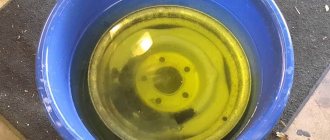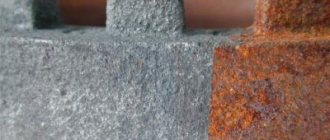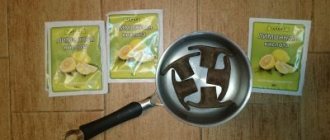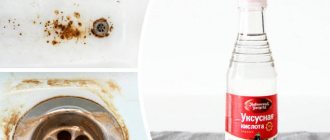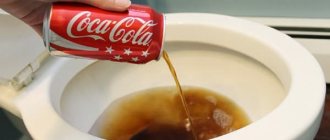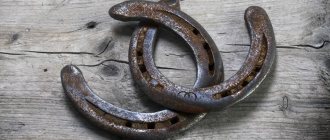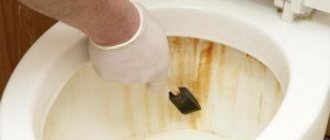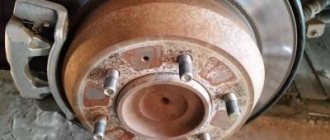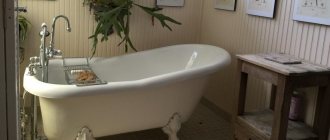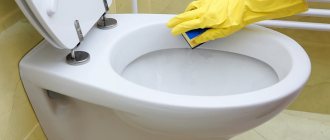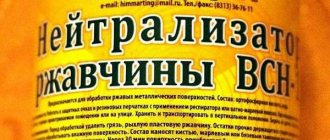The appearance of “saffron milk caps” on the car body is an extremely dangerous problem that requires an immediate solution. Otherwise, the metal under the chips will begin to succumb to oxidation, and the scratches will increase in size and deepen. Through holes will appear on the surface, and the body will lose its attractive appearance and strength. As a result, a seemingly harmless speck of rust will cause the need to completely replace the damaged part.
In addition, if you decide to sell a corroded car, do not count on a good deal: the cost of the car will drop by 2 or even 3 times. Therefore, you will have to replace the rusting elements, and this procedure is neither quick nor cheap.
It is very difficult to stop the development of the corrosion process, but in less advanced cases it is possible. The most common method for removing rust stains on a car body is to treat them with phosphoric acid.
What is phosphoric acid and how is it used?
Orthophosphoric acid is a powder that is diluted with water and is used in various industries, as well as medicine. The acid is used in diluted form, 85% aqueous solution, which does not have a pungent odor. The acid is used in the production of household products that are used to remove rust. It is also added to primer mixtures for metal. After treating the surface with orthophosphoric acid, a protective layer is formed that prevents the material from destruction.
What is phosphoric acid?
Orthophosphoric (phosphoric) acid is a water-soluble product of inorganic origin, produced in the form of an 85% aqueous solution of a syrupy, colorless consistency. It is used in various industries, including food. It is one of the main components in the production of phosphate chemical fertilizers and is also used in dentistry.
In the production of household chemicals, this acid is also used quite actively - it is present in almost all industrial products for combating rust. But metal primers are produced based on it, and the rust converter contains it as the main ingredient.
Basic precautions when working with phosphoric acid
When removing rust chemically, it is necessary to protect the respiratory tract and hands; for this, use a respirator and gloves. Since the evaporation of acid can cause burns to the respiratory tract and skin. In addition, the product is a fire hazard, so when working it is necessary to ensure good ventilation in the room. If acid gets on the skin, you must immediately rinse the area with plenty of water for about 15 minutes. If the damage is significant, you should immediately visit the hospital. Do not wipe the product with a napkin or towel.
Applications of phosphoric acid
Modern science quite often allows the same chemical substance or the same chemical composition to be used for completely different purposes. The same can be said about the options for using phosphoric acid.
Today, there are a considerable number of different areas of application of orthophosphoric acid. So, for example, this acid can be used in organic synthesis. It is used in cases where it is necessary to create phosphorus salts of sodium, calcium, aluminum, and manganese.
The use of orthophosphoric acid in the metalworking industry is also of great importance, since orthophosphoric acid is practically irreplaceable here, the effect of which has been proven in removing rust or preventing its occurrence.
Phosphoric acid can also be found in a large number of substances intended for use by housewives in everyday life. It is also known to be used in the medical and food industries.
Other areas where phosphoric acid can be used include:
- Oil industry
- Making matches,
- Film production,
- Production of fire-resistant or fire-resistant items and materials.
The role of orthophosphoric acid is also great in the process of feeding plants, since the beneficial effect of phosphorus on the ability of plants to produce high yields is widely known. Thanks to this acid, agricultural crops become resistant to frost and other unfavorable conditions.
The beneficial effect on the soil is also noted in many sources related to the subject of agriculture or the national economy.
The importance of orthophosphoric acid is also important for animals. Not only does it, together with other organic substances, participate in the metabolic processes of the animal body, but it also helps in the formation of shells and other natural growths in some species of animals, since they contain calcium phosphate.
Phosphoric acid is also used as a food additive in some food products. It has code E 338. This acid finds its purpose in the food industry in the production of sausages, some types of processed cheeses, and carbonated drinks.
It should be noted that you should not abuse food products that contain orthophosphoric acid, since it is not clear what the rate of human consumption per day is. But in any case, the benefit from its consumption is disproportionately small, if not even negligible, in comparison with the harm that it can cause in the form of disruption of the gastrointestinal tract, the occurrence of caries, and the development of osteoporosis.
How to properly remove rust using phosphoric acid
The advantage of phosphoric acid is that it removes loose rust and also forms a thin layer that serves as protection. The acid is capable of corroding rust and providing a protective film in the form of an oily surface.
Methods for removing rust depend on the degree of damage:
- cleansing of elements by complete immersion in the product;
- surface treatment using a roller or spray;
- applied to metal products after mechanical cleaning.
Why orthophosphoric?
One of the most important advantages of using this method is the formation of a thin protective film on the metal surface after thorough cleaning of the loose mass of oxides. Thanks to this, the treated body element will be reliably protected for some time from further development of corrosion.
The principle of action of the acid is that it corrodes and absorbs iron oxide, while phosphating the surface. Therefore, after the procedure and the product has completely dried, a grayish oily film forms in place of the “saffron milk caps”.
The acid composition removes rust very quickly - in just 1-2 hours. In addition, the use of this method does not involve subsequent painting, since it does not affect the factory paint layer, and does not require the use of specialized tools: a drill, an angle grinder, a sandblasting unit, or even sandpaper.
Purification of elements by complete immersion in phosphoric acid
If you have a sufficient amount of the product, you can use the full immersion method to remove rust. To do this, you first need to degrease the element to be cleaned using a detergent composition, and then wash it thoroughly. After this, pour 100 grams of an 85% acid solution into the prepared container and add 1 liter of water. The element to be cleaned is immersed in the solution for one hour, stirring the product periodically. Then the product must be removed and washed well. After such cleaning, the product is washed with another solution consisting of 50% water, 2% ammonia and 48% alcohol. Then the product is washed again with plain water and dried. All stages must be performed in strict sequence. If you do not degrease the product, the cleaning will be uneven, since the product may not corrode normal stains, and additional cleaning will be required. In this way, you can clean any products with varying degrees of rust, but the thicker the coating, the more time you need to keep the element in the solution. If the element is not dried after washing, hydroxide appears on it. Drying can be done using any method.
Which is better to choose?
When choosing a rust remover, you need to focus on the place where it will be used. Full immersion cleaning of parts requires a large volume of acid. Here, the purchase of orthophosphoric acid of 85% concentration will be justified from both a practical and economic point of view. If you need to not only remove rust, but also create a protective layer under the paintwork, then a self-made solution will not work. In this case, it is better to buy a factory converter with all the necessary additives.
You also need to consider whether a layer of primer will be applied or not. Converter-modifiers increase the water-repellent and inhibitory properties of the primer, but are not primers themselves. But after treatment with the converter-primer, you can immediately coat the metal with paint.
In conclusion, I would like to focus on the fact that phosphoric acid creates a protective layer during the interoperative period. That is, without paint coating, the metal will be susceptible to corrosion.
Cleaning rust by applying phosphoric acid to the surface
If the product cannot be immersed due to its size or there is a small amount of product available, then the method of applying acid to the surface with a spray, roller or brush is used. But first it is necessary to indicate the extent of the damage.
If there is significant plaque, you must first remove the top layer using a grinder and a metal brush. Then the surface is degreased and a solution of orthophosphoric acid is sprayed. In this case, the solution should be applied to the entire affected surface, without gaps. After two hours, wash the area with a neutral solution. At the end, a final rinse is performed and the treated area is thoroughly dried.
If the rust layer is small, you can skip cleaning with a brush, but immediately begin degreasing and applying the solution. But re-spraying may be required if cleaning is not complete.
Using orthophosphoric acid, you can clean bathtubs, washbasins and toilets; it completely cleans rusty deposits on enamel surfaces. For products made of acrylic material, such cleaning is not acceptable.
For enameled and earthenware products, you need to dilute 100 grams of acid with 500 milliliters of water. First, the surface is degreased using a detergent and thoroughly cleaned from household contaminants. Then apply acid and wash it off with soda solution. To do this, dilute 1 spoon of soda in a liter of water. In this case, no friction is produced, as a result the enamel surface retains its integrity.
When using acid, do not allow it to come into contact with the skin, otherwise it is necessary to rinse the area with water for a long time.
Getting rid of rust
The great advantage of orthophosphoric acid is its ability to form a rust-protecting film on the product, and not just get rid of a lot of oxides. The process of forming such a protective barrier is easy to describe: the acid, destroying iron oxide, phosphorizes (strengthens) the top layer of the metal. After such manipulations, a grayish and oily film can often be observed on metal products, which appears instead of rust.
There are many ways to remove rust, depending on the degree of rust damage and the size of the item to be cleaned:
- Etching an object by completely placing it in a solution;
- Cleaning the surface of the product by using a roller or spray;
- Distribution of acid over metal after its preparatory cleaning.
Etching of parts thanks to complete immersion.
If you have enough phosphoric acid at home and a large container, the easiest way to get rid of rust is to completely place the product in the mixture. To do this, repeat the order of the work:
- Rinse the product under water using detergent; this will degrease the part;
- Mix the components in a container based on the proportion: 100-150 g of 85% acid to one liter of water;
- Let the part sit in the resulting mixture for an hour, stirring it occasionally;
- Remove the cleaning item and then rinse it thoroughly;
- Mix the neutralizing solution based on the ratio: 50% water to 48% alcohol and 2% ammonia;
- Wipe the product with the resulting solution, then clean with water and dry.
All stages are interconnected, so if you skip any of them, you will not achieve the desired result. Thus, if degreasing is not performed, the etching will proceed unevenly and the uncleaned areas will have to be re-cleaned using other methods. The full immersion pickling method is suitable for items that have some level of corrosion, but cleaning time may increase depending on the thickness of the rust layer.
How to make a toilet snow-white and remove rust stains
Advice! To avoid the formation of unwanted hydroxide, after washing you need to dry the part, and you can dry it in any convenient way.
How to distribute acid over a surface.
An item affected by rust may be of impressive size, and large containers and sufficient amounts of acid may not be at hand. In this case, phosphoric acid should be applied directly to the part. This can be done with a roller, sprayer or brush made of natural material. With this approach, it is very important to take into account the level of rust damage. When corrosion has become deeply ingrained into a part, the best solution is to remove the top layer by hand or using a grinder.
Then degreasing is carried out, after which it is necessary to distribute this acid solution over the products without gaps and keep them on for 2 hours. After this, you need to remove the acid with a neutralizing mixture, rinse and dry for the last time. If the corrosion is minor, it is possible to cope without resorting to mechanical cleaning, simply repeat the procedure several times.
Getting rid of corrosion on bathtubs, toilets and sinks.
Due to the fact that orthophosphoric acid perfectly fights traces of rusty water on sanitaryware and enameled surfaces, it is used instead of household chemicals. This will not help owners of acrylic bathtubs.
Procedure for cleaning earthenware and enamel surfaces:
- Dilute every 500 ml of water with 100 g of 85% acid;
- Using any detergent, degrease the surface;
- Treat the affected surface with a brush made of natural material;
- After a couple of hours, you need to wash off the acid using a soda solution (1 tablespoon/liter of water).
The main advantage of this method of getting rid of corrosion is that the enamel is not destroyed due to friction. Note to housewives who use Coca-Cola for the same purposes: it acts this way thanks to the orthophosphoric acid in its composition. Thus, it is more profitable to use orthophosphoric acid in the correct volume, and to use the products for their intended purpose.
Ways to remove rust stains on clothes at home
Rust converter.
The rust modifier or converter is the same solution of orthophosphoric acid, but with some additives. They are divided into several groups, depending on these additives:
- modifiers-stabilizers,
- primers,
- rust converters.
What to choose?
When choosing a method for getting rid of rust, you must first take into account the location where the acid will be used. For example, to clean a part using the full immersion method, a large amount of phosphoric acid is needed. And if you need to not only get rid of rust, but also create a preparatory layer for applying paint, then a mixture prepared by yourself will not work. For such purposes, it is worth purchasing a factory converter, which will already contain all the necessary additives.
How to properly store and transport phosphoric acid
Phosphoric acid is an aggressive agent, so it is necessary to follow certain rules when transporting and storing this substance. The powder must be placed in an airtight container. To prevent foreign elements from getting into the acid, all containers must be used clean and dry, then the prepared solution will be of high quality.
Preparing a low-quality composition can result in dangerous vapor poisoning or lack of the desired result. Store containers with acid in a dry and warm place where there is no dampness or condensation. There is no need to pour the powder into another container; it is better to leave it in the original packaging. Such cargo is considered dangerous, so special documentation is required to transport it over long distances.
Recommendations for cleaning products with phosphoric acid
Cleaning is done with care so that the metal surface does not become too thin and holes are formed. During preliminary mechanical cleaning, disks with large elements cannot be used, otherwise significant damage to the surface can be caused.
Before starting the main work, the remaining surface must be covered with film, since exposure to such a strong product may damage the rest of the coating. Therefore, processing must be carried out carefully so that the damaged surface does not have to be restored, which will lead to additional costs.
If the work is done correctly, the result is a reliable and durable surface that does not contain rust stains, which lead to the destruction of metal products.
When applying orthophosphoric acid to a surface, it is necessary to wear gloves and a respirator; they serve as means of protection against the harmful substance. If acid gets on clothing, it must be removed immediately so that the product does not get on the skin and cause a burn.
Advantages of using orthophosphorus composition
The use of this chemical component in the processing of metal products is actively used in numerous converters. They not only dissolve existing oxides, but also create a protective film cover. In addition, the advantage of this solution is that it is completely safe for metal. Phosphoric acid removes oxides and converts metal rust into iron phosphates.
This composition is used for cleaning and washing: rolled metal products, including fittings, pipe surfaces, water supply and heating systems, cast iron objects, wells and boilers. In addition, it is used for processing heat exchangers, heaters, boilers, coils, as well as numerous metal elements of mechanisms and cars.
The most popular products include zinc, which has additional ingredients: manganese and acid + zinc. They increase the strength of the protective layer on the surface of the processed part. The retail price of these drugs is low. Using a self-prepared composition or a store-bought converter, follow all safety precautions when working with these dangerous substances, and also carefully read the instructions for their use. For a clear understanding of the rye removal operation being carried out, watch an additional video with the product processing procedure.
We also recommend reading:
Essential hacks: (November 2019)
Phosphoric acid is a relatively weak acid used in a surprising number of applications: rust removal, dentistry, disinfection, pharmaceuticals, food (just think of the Coke sting from the phosphoric acid) and antifreeze, to name a few. (Ref 1 page 6) However, a phosphoric acid spill is dangerous to both your health and the environment, and even if thoroughly done, it should still be neutralized and cleaned up. By their nature, acids are neutralized by bases. Using a suitable and convenient base material and taking a few precautions will make cleaning safe and fairly simple.
Basic rules when using phosphoric acid to remove rust
- Before starting the main work, it is necessary to prepare all protective equipment, since the substance is aggressive and leaves burns if it comes into contact with the skin.
- First, the surface must be cleaned of normal contaminants so that the product can perform its functions fully, otherwise the surface will be cleaned in parts.
- If the rust layer is too thick, then it is necessary to resort to mechanical cleaning of the surface; for this, use a grinder and a metal brush.
- The cleansing area must be degreased and then rinsed with water so that the product adheres well and works effectively.
- After finishing the cleansing, the acid must be washed off with a neutral solution and then with water.
- Since the substance is aggressive, it can damage the main surface, so it must be covered with film.
- If it is not possible to clean by immersion, then use sprayers or apply acid with a brush or roller to the rusty surface.
- If the surface is not clean after the first application, additional spraying will be required. After this, the area to be cleaned must be washed with a neutral solution and then with water.
- Phosphoric acid cannot be used to clean rust on acrylic surfaces.
Benefits of Phosphoric Acid for Rust Removal
- Orthophosphoric acid removes rusty deposits well on enamel and earthenware products, on metal surfaces, and is actively used in the automotive industry.
- Using this product you can remove rust without rubbing the surface, this helps preserve the enamel.
- Phosphoric acid forms a film on the cleaned area, which serves to protect the surface from new corrosion and other damage.
- This acid can be used to clean bathtubs, toilets and washbasins, as well as other household appliances that have a similar surface.
- Phosphoric acid helps remove rust stains and subsequently protect the surface from corrosion damage.
When working with acid, it is necessary to wear protective equipment, a respirator and gloves, as the substance is aggressive. Before applying acid, the surface must be degreased using detergents, then rinsed well with water, and then sprayed with acid. After the required time has passed, the acid is washed off with a neutral solution based on alcohol, ammonia and water. After this, the surface is washed with water and dried. If the rust layer is too thick, then it must first be cleaned with a metal brush or grinder with a special attachment. The work must be performed in the correct sequence; if you skip at least one step, this will lead to poor quality cleaning.
Rust converter
A rust converter (rust modifier) is a solution of the same orthophosphoric acid, but with special additives. Depending on the additives, these drugs are divided into several groups:
- primers,
- modifiers-stabilizers,
- rust converters.
An example of the first group is the EVA-0112 primer, which consists of two components - a base and 85% acid. It is used as a base for paint for steel products. The Tsinkar converter also contains orthophosphoric acid with the addition of zinc and manganese salts. Thanks to these additives, a hardened protective layer is obtained from the converted rust (metal alloying effect). Before using the converter, you must read the instructions, and the composition can only be used in accordance with the manufacturer’s recommendations.
